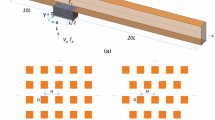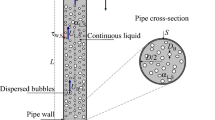Abstract
This study considers a model for coupled predictions of flows in domains containing a fluid-saturated porous medium and a free stream. The model is based on the generalized Navier–Stokes equations for an incompressible fluid, obtained by averaging over a representative elementary volume of the porous medium and written for the entire computational domain consisting of two subdomains differing in composition. To implement this model numerically, we develop a computational algorithm based on the finite element method and Newton’s method for solving nonlinear equations. It is implemented using the open computational platform FEniCS. The developed numerical technique is verified on the known numerical results of other authors. In addition, the model predictions of flows in an automobile catalytic converter are performed and discussed.







Similar content being viewed by others
RЕFERENCES
A. Bejan, I. Dincer, S. Lorente, A.F. Miguel, and A.H. Reis, Porous and Complex Flow Structures in Modern Technologies (Springer, New York, 2004). https://doi.org/10.1007/978-1-4757-4221-3
Handbook of Porous Media, Ed. by K. Vafai, 3rd ed. (CRC Press, Boca Raton, FL, 2015).
M. K. Das, P. P. Mukherjee, and K. Muralidhar, Modeling Transport Phenomena in Porous Media with Applications (Springer, Cham, 2018). https://doi.org/10.1007/978-3-319-69866-3
R. Helmig, B. Flemisch, M. Wolff, and and B. Faigle, “Efficient modeling of flow and transport in porous media using multi-physics and multi-scale approaches,” in Handbook of Geomathematics, 2nd ed., Ed. by W. Freeden, M. Z. Nashed, and T. Sonar (Springer, Berlin, 2015), pp.703−749. https://doi.org/10.1007/978-3-642-54551-1_15
H. P. G. Darcy, Les Fontaines Publiques de la Ville de Dijon (Victor Dalmont, Paris, 1856).
H. C. Brinkman, “A calculation of the viscous force exerted by a flowing fluid on a dense swarm of particles,” Appl. Sci. Res., Ser. A 1 (1), 27−34 (1947). https://doi.org/10.1007/BF02120313
P. Forchheimer, “Wasserbewegung durch Boden,” Z. Ver. Deutsch. Ing. 45 (50), 1782−1788 (1901).
S. Whitaker, The Method of Volume Averaging (Springer, Dordrecht, 1999), https://doi.org/10.1007/978-94-017-3389-2
M. Kaviany, Principles of Heat Transfer in Porous Media, 2nd ed. (Springer, New York, 2012). https://doi.org/10.1007/978-1-4612-4254-3
D. A. Nield and A. Bejan, Convection in Porous Media, 5th ed. (Springer, Cham, 2017). https://doi.org/10.1007/978-3-319-49562-0
M. Nazari, Y. Mahmoudi, and K. Hooman, “Introduction to fluid flow and heat transfer in porous media,” in Convective Heat Transfer in Porous Media, Ed. by Y. Mahmoudi, K. Hooman, and K. Vafai (CRC Press, Boca Raton, FL, 2020), pp. 3−18. https://doi.org/10.1201/9780429020261-1
B. Goyeau, D. Lhuillier, D. Gobin, and M. G. Velarde, “Momentum transport at a fluid−porous interface,” Int. J. Heat Mass Transfer 46 (21), 4071−4081 (2003). https://doi.org/10.1016/S0017-9310(03)00241-2
D. Gobin and B. Goyeau, “Natural convection in partially porous media: a brief overview,” Int. J. Numer. Methods Heat Fluid Flow 18 (3/4), 465−490 (2008). https://doi.org/10.1108/09615530810853592
M. Ehrhardt, J. Fuhrmann, E. Holzbecher, and A. Linke, “Mathematical modeling of channel-porous layer interfaces in PEM fuel cells,” WIAS Preprint No. 1375 (Weierstrass Institute for Applied Analysis and Stochastics, Berlin, 2008).
M. Discacciati, “Coupling free and porous-media flows: Models and numerical approximation,” in Simulation of Flow in Porous Media: Applications in Energy and Environment, Ed. by P. Bastian, J. Kraus, R. Scheichl, and M. Wheeler (De Gruyter, Berlin, 2013), pp. 107−138. https://doi.org/10.1515/9783110282245.107
P. Angot, B. Goyeau, and J. A. Ochoa-Tapia, “Asymptotic modeling of transport phenomena at the interface between a fluid and a porous layer: Jump conditions,” Phys. Rev. E 95 (6), 063302 (2017). https://doi.org/10.1103/PhysRevE.95.063302
E. Eggenweiler and I. Rybak, “Unsuitability of the Beavers−Joseph interface condition for filtration problems,” J. Fluid Mech. 892, A10 (2020). https://doi.org/10.1017/jfm.2020.194
I. Rybak, C. Schwarzmeier, E. Eggenweiler, and U. Rüde, “Validation and calibration of coupled porous-medium and free-flow problems using pore-scale resolved models,” Comput. Geosci. 25 (2), 621−635 (2021). https://doi.org/10.1007/s10596-020-09994-x
B. Alazmi and K. Vafai, “Analysis of variants within the porous media transport models,” ASME J. Heat Transfer 122 (2), 303−326 (2000). https://doi.org/10.1115/1.521468
C. T. Hsu and P. Cheng, “Thermal dispersion in a porous medium,” Int. J. Heat Mass Transfer, 33 (8), 1587−1597 (1990). https://doi.org/10.1016/0017-9310(90)90015-M
M. J. S. de Lemos, Turbulence in Porous Media: Modeling and Applications, 2nd ed. (Elsevier, London, 2012).
FEniCS Project. https://fenicsproject.org/. Cited September 22, 2022.
Automated Solution of Differential Equations by the Finite Element Method: The FEniCS Book, Ed. by A. Logg, K.‑A. Mardal, and G. N. Wells (Springer, Berlin, 2012). https://doi.org/10.1007/978-3-642-23099-8
R. Glowinski, “Finite element methods for incompressible viscous flow,” in Numerical Methods for Fluids (Part 3), Ed. by P. G. Ciarlet and J. L. Lions, Handbook of Numerical Analysis, Vol. 9 (Elsevier, Amsterdam, 2003), pp. 3−1176. https://doi.org/10.1016/S1570-8659(03)09003-3
V. John, Finite Element Methods for Incompressible Flow Problems (Springer, Cham, 2016). https://doi.org/10.1007/978-3-319-45750-5
MUMPS: MUltifrontal Massively Parallel sparse direct Solver. http://mumps.enseeiht.fr/. Cited September 22, 2022.
Gmsh. https://gmsh.info/. Cited September 22, 2022.
ParaView. https://www.paraview.org/. Cited September 22, 2022.
D. K. Garthling, C. E. Hickox, and R. C. Givler, “Simulation of coupled viscous and porous flow problems,” Int. J. Comput. Fluid Dyn. 7 (1-2), 23−48 (1996). https://doi.org/10.1080/10618569608940751
V. A. F. Costa, L. A. Oliveira, B. R. Baliga, and A. C. M. Sousa, “Simulation of coupled flows in adjacent porous and open domains using a control-volume finite-element method,” Numer. Heat Transfer, Part A: Appl. 45 (7), 675−697 (2004). https://doi.org/10.1080/10407780490424839
L. Betchen, A. G. Straatman, and B. E. Thompson, “A nonequilibrium finite-volume model for conjugate fluid/porous/solid domains,” Numer. Heat Transfer, Part A: Appl. 49 (6), 543−565 (2006). https://doi.org/10.1080/10407780500430967
M. Nordlund, M. Stanic, A. K. Kuczaj, E. M. A. Frederix, and B. J. Geurts, “Improved PISO algorithms for modeling density varying flow in conjugate fluid-porous domains,” J. Comput. Phys. 306, 199−215 (2016). https://doi.org/10.1016/j.jcp.2015.11.035
A. S. Kozelkov, S. V. Lashkin, V. R. Efremov, K. N. Volkov, and Yu. A. Tsibereva, “An implicit algorithm for solving Navier–Stokes equations to simulate flows in anisotropic porous media,” Comput. Fluids 160, 164−174 (2018). https://doi.org/10.1016/j.compfluid.2017.10.029
Z. Li, H. Zhang, Y. Liu, and J. M. McDonough, “Implementation of compressible porous–fluid coupling method in an aerodynamics and aeroacoustics code part I: Laminar flow,” Appl. Math. Comput. 364, 124682 (2020). https://doi.org/10.1016/j.amc.2019.124682
R. E. Hayes, A. Fadic, J. Mmbaga, and A. Najafi, “CFD modelling of the automotive catalytic converter,” Catal. Today 188 (1), 94−105 (2012). https://doi.org/10.1016//j.cattod.2012.03.015
S. Porter, J. Saul, S. Aleksandrova, H. Medina, and S. Benjamin, “Hybrid flow modelling approach applied to automotive catalysts,” Appl. Math. Modell. 40 (19-20), 8435−8445 (2016). https://doi.org/10.1016/j.apm.2016.04.024
H. A. Ibrahim, W. H. Ahmed, S. Abdou, and V. Blagojevic, “Experimental and numerical investigations of flow through catalytic converters,” Int. J. Heat Mass Transfer 127 (Part B), 546−560 (2018). https://doi.org/10.1016/j.ijheatmasstransfer.2018.07.052
M. Hettel, E. Daymo, T. Schmidt, and O. Deutschmann, “CFD-Modeling of fluid domains with embedded monoliths with emphasis on automotive converters,” Chem. Eng. Process.: Process Intensif. 147, 107728 (2020). https://doi.org/10.1016/j.cep.2019.107728
Funding
This study was funded by the Russian Foundation for Basic Research and the National Science Foundation of Bulgaria, project no. 20-51-18004.
Author information
Authors and Affiliations
Corresponding authors
Ethics declarations
The authors declare that they have no conflicts of interest.
Rights and permissions
About this article
Cite this article
Churbanov, A.G., Churbanova, N.G. & Trapeznikova, M.A. Coupled Prediction of Flows in Domains Containing a Porous Medium and a Free Stream. Math Models Comput Simul 15, 643–653 (2023). https://doi.org/10.1134/S207004822304004X
Received:
Revised:
Accepted:
Published:
Issue Date:
DOI: https://doi.org/10.1134/S207004822304004X




